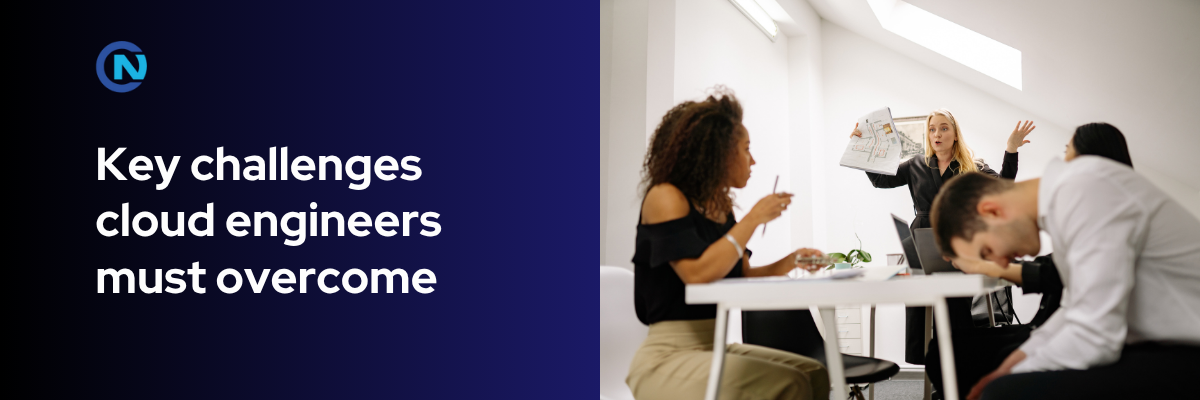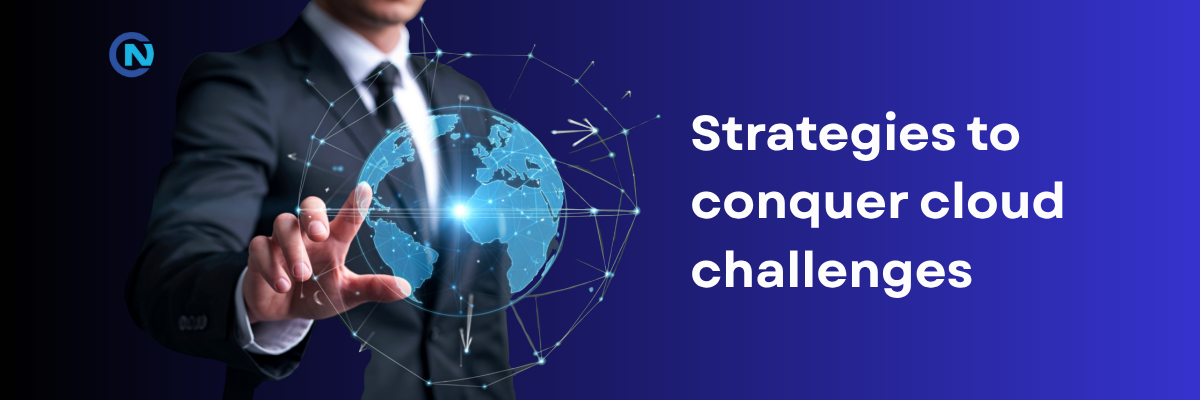
Cloud engineering offers tremendous benefits scalability, agility, and innovation, but along with those come serious challenges. Engineers must confront issues relating to security, cost, complexity, and skills. Below are the key problems, followed by strategies to address them.
Key challenges cloud engineers must overcome

1. Misunderstanding of shared responsibility & security misconfigurations
One of the most fundamental challenges is that engineers or organizations often misinterpret the shared responsibility model. Many assume the cloud provider handles more than it actually does, leaving data, access control, APIs, identity management, and configuration security in an insecure state. According to Check Point via TechMonitor, one in three IT professionals believes that cloud security is the provider’s responsibility alone.
Misconfigurations are exceedingly common. A survey by McAfee revealed that 99% of IaaS misconfigurations go unnoticed. Research from Trend Micro and others shows misconfiguration is named the top cloud security risk, with hundreds of millions of misconfiguration incidents daily.
2. Cost Overruns, Poor Visibility, and Unpredictable Billing
Cloud’s pay‑as‑you‑go model is powerful, but also unpredictable without strong cost control. Many organizations experience unexpected bills due to overprovisioned resources, wasted or idle services, cross‑region or egress costs, and a lack of unified visibility. For example, a survey by Virtana found that 82% of organizations with workloads in public clouds have incurred “unnecessary” cloud costs. A TechRadar survey reported that 94% of IT decision makers find controlling cloud costs challenging.
Some firms are also over budget bdar)y 20‑40%, especially in big data workloads or large-scale cloud usage.
3. Complexity in Multi‑Cloud / Hybrid Environments
As enterprises mature, many adopt a multi-cloud (using two or more public providers) or hybrid strategy (combining public cloud with on-premises data centers). While strategic, this choice dramatically escalates operational complexity.
Engineers must manage tool sprawl across disparate platforms, each with its own APIs, management consoles, logging formats, security models, and billing structures. This fragmentation leads to:
- Inconsistent Governance: Difficulty enforcing uniform security and compliance standards.
- Fragmented Monitoring: Metrics are inconsistent and scattered, leading to blind spots and inefficient management (criticalcloud.ai).
- Kubernetes Complexity: Managing container orchestration across various clouds and on-premises infrastructure is a major pain point (Rafay Systems).
This complexity not only introduces risk but also significantly hampers team productivity, contributing to wasted budget portions due to inefficiencies.
4. Skills Gap & Continuous Learning Pressure
Cloud platforms evolve rapidly. New services, security threats, best practices, and deployment paradigms emerge constantly. Many organizations face a lack of staff skilled across multiple clouds and specialized domains such as security, Kubernetes, and cost optimization. The combination of urgency, learning overhead, and the need to deliver day‑to‑day operations creates burnout risk and technical debt.
According to Virtualization Review, lack of cloud management skills or expertise was cited by about a third of respondents as a major challenge.
Strategies to conquer cloud challenges

Having identified these problems, here are strategies and solutions that can help cloud engineers and organizations manage and overcome them.
A. Strengthening Security & Understanding Shared Responsibility
- Deep education on shared responsibility: Organizations should ensure that engineers, DevOps teams, and leadership understand exactly what the provider secures and what the customer must secure. Regular training and reviews help reduce misassumption gaps.
- Automate misconfiguration detection: Use tools such as Cloud Security Posture Management (CSPM) to scan continuously for incorrectly configured resources, drift over time, open access, and risky IAM permissions.
- Implement least privilege and strong access controls: Identity and Access Management (IAM) policies should be tightly controlled, only granting minimal necessary permissions. Enforce multi‑factor authentication (MFA) and avoid using overly broad roles or credentials.
- Improve monitoring, logging, and visibility: Centralize logs, deploy alerting for configuration changes, track asset inventory, and enforce auditing. Having full visibility helps prevent silent breaches.
B. Controlling Costs & Improving Visibility
- Adopt a FinOps mindset and framework: Make cost management part of team culture. Provide engineers responsibility and tools to monitor cost, forecast usage, set budgets, and respond proactively to alerts. Automate notifications when costs or usage deviate from expected patterns.
- Use reserved or committed use discounts for stable workloads: For predictable resources, reserved instances or committed use can save significant money. For variable or non‑critical workloads, use spot instances or autoscaling.
- Turn off or scale down idle or non‑critical resources: Development and test environments often drive waste. Scheduling their shutdown or automatically scaling them when idle saves cost.
- Aggregate billing and unify dashboards: Use tools that provide a single view of cost across clouds. Reduce blind spots by consolidating billing information, tagging resources correctly, and setting clear rules for cost attribution.
C. Managing Multi‑Cloud / Hybrid Complexity
- Define governance policies for cross‑cloud consistency: Establish standards for IAM, tagging, naming, encryption, network configuration, and enforce them via policy‑as‑code.
- Infrastructure as Code (IaC): Tools like Terraform allow declarative definitions of infrastructure, making provision, configuration, versioning, and drift control more manageable across multiple clouds.
- Standardize metrics and monitoring: Use tools or frameworks that support unified metric collection, logging, and alerting across clouds. For example, adopt standards like OpenTelemetry so you have consistent observability.
- Evaluate whether multi‑cloud is necessary: Sometimes a simpler cloud strategy (single provider or limited hybrid) reduces overhead without sacrificing benefits. Multi‑cloud should be chosen for strategic reasons (redundancy, compliance, specific services), not just a trend.
D. Closing the Skills Gap & Enabling Continuous Learning
- Invest in training, certifications, and internal upskilling programs: Make time and budget for your team to learn new features, security practices, and architectures.
- Promote cross‑team collaboration and mentorship: Teams with DevOps, Security, and Operations working together can share knowledge. Mentoring helps spread expertise.
- Encourage experimentation and sandbox environments: Provide safe “playgrounds” for automating routine work to reduce burnout and free up time for innovation. Kubernetes lifecycle management, security scanning, and cost anomaly detection are areas suited for automation.
- In technology, tools and automation are indispensable, but they are not enough. Human collaboration, community insight, and shared experience often prove to be the glue that holds ambitious cloud programs together. Peer networks, case studies, and collective wisdom accelerate problem‑solving and avoid repeated mistakes.
- One standout in this space is CloudOps Network, a global platform designed to connect certified cloud professionals, DevOps teams, and partner organizations. According to its official site, CloudOps Network matches certified engineers with cloud partner firms and projects, enabling participants to gain exposure to real‑world problems, earn rewards like cloud credits, and scale their portfolios.
Conclusion
Cloud engineering involves navigating a landscape packed with rapid change, ambiguity, rising costs, and increasing complexity. The major challenges include misconfigured security and unclear responsibility boundaries, cost overruns & lack of visibility, fragmentation in multi‑cloud or hybrid setups, and a persistent skills gap. But these challenges are not insurmountable.
By understanding security responsibilities clearly, automating detection, governing infrastructure with well‑defined policies, adopting FinOps and cost discipline, investing in learning, and leveraging shared learning through platforms and communities like CloudOps Network, engineers and organizations can build a robust foundation. With the right approach, the cloud becomes not a source of risk, but a platform of opportunity and innovation.

